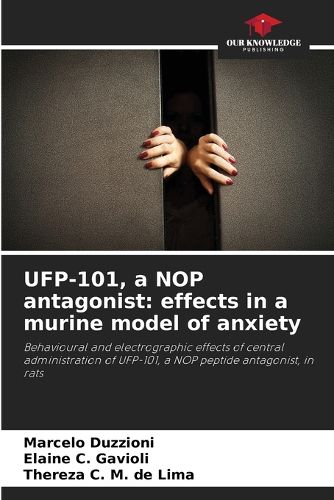Readings Newsletter
Become a Readings Member to make your shopping experience even easier.
Sign in or sign up for free!
You’re not far away from qualifying for FREE standard shipping within Australia
You’ve qualified for FREE standard shipping within Australia
The cart is loading…






Central administration of [Nphe1, Arg14, Lys15]N/OFQ-NH2 (UFP-101), an antagonist of the NOP receptor, showed an anxiolytic effect in rats submitted to the elevated T maze test (LTE). Prior treatment with a peptidase inhibitor (bestatin) and another serotonin synthesis inhibitor (PCPA) blocked this response, suggesting that a C-terminal fragment and the serotonergic system are involved in the anxiolytic-like effect of UFP-101 in the LTE. Administration of UFP-101 into the dorsal raphe nucleus also showed an anxiolytic-like effect on the LTE. In the sphere hiding test (SST), central administration of UFP-101 also showed an anxiolytic effect. However, this effect was resistant to blockade by naloxone, a non-selective opioid receptor antagonist. Central administration of UFP-101 reduced the firing rate of noradrenergic neurons in the locus ceruleus (LC), but this effect was not blocked by intravenous administration of naloxone (no effect per se), indicating that modulation of the electrical activity of LC noradrenergic neurons does not appear to be one of the mechanisms responsible for the anxiolytic-like effect of UFP-101.
$9.00 standard shipping within Australia
FREE standard shipping within Australia for orders over $100.00
Express & International shipping calculated at checkout
Stock availability can be subject to change without notice. We recommend calling the shop or contacting our online team to check availability of low stock items. Please see our Shopping Online page for more details.
Central administration of [Nphe1, Arg14, Lys15]N/OFQ-NH2 (UFP-101), an antagonist of the NOP receptor, showed an anxiolytic effect in rats submitted to the elevated T maze test (LTE). Prior treatment with a peptidase inhibitor (bestatin) and another serotonin synthesis inhibitor (PCPA) blocked this response, suggesting that a C-terminal fragment and the serotonergic system are involved in the anxiolytic-like effect of UFP-101 in the LTE. Administration of UFP-101 into the dorsal raphe nucleus also showed an anxiolytic-like effect on the LTE. In the sphere hiding test (SST), central administration of UFP-101 also showed an anxiolytic effect. However, this effect was resistant to blockade by naloxone, a non-selective opioid receptor antagonist. Central administration of UFP-101 reduced the firing rate of noradrenergic neurons in the locus ceruleus (LC), but this effect was not blocked by intravenous administration of naloxone (no effect per se), indicating that modulation of the electrical activity of LC noradrenergic neurons does not appear to be one of the mechanisms responsible for the anxiolytic-like effect of UFP-101.